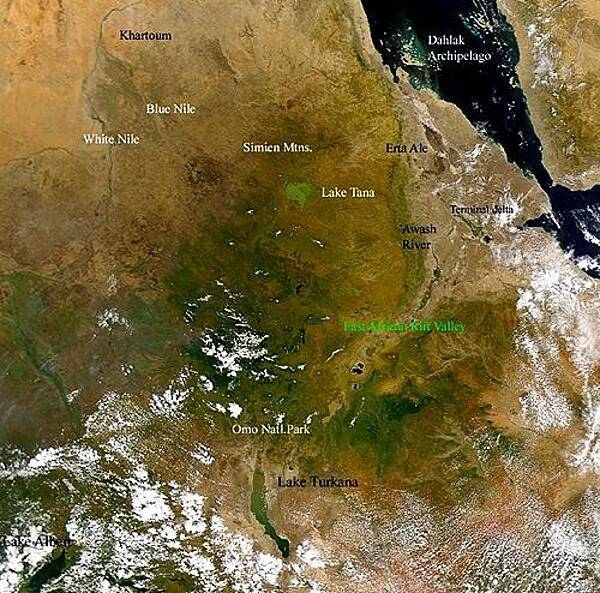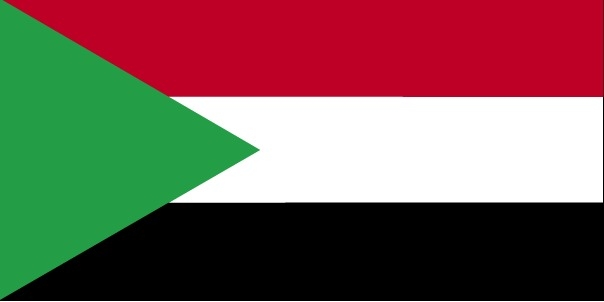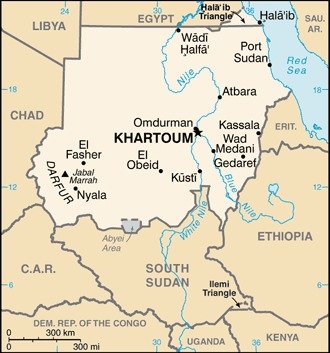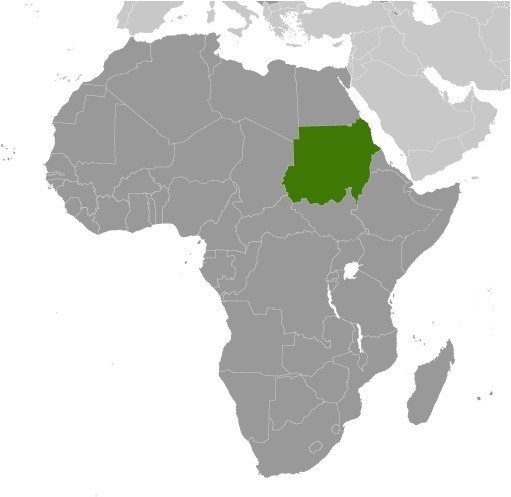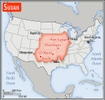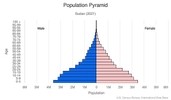Introduction
Background
Long referred to as Nubia, modern-day Sudan was the site of the Kingdom of Kerma (ca. 2500-1500 B.C.) until it was absorbed into the New Kingdom of Egypt. By the 11th century B.C., the Kingdom of Kush gained independence from Egypt; it lasted in various forms until the middle of the fourth century A.D. After the fall of Kush, the Nubians formed three Christian kingdoms of Nobatia, Makuria, and Alodia. The latter two endured until around 1500. Between the 14th and 15th centuries much of Sudan was settled by Arab nomads, and between the 16th–19th centuries it underwent extensive Islamization. Following Egyptian occupation early in the 19th century, the British established an Anglo-Egyptian Sudan - nominally a condominium, but in effect a British colony.
Military regimes favoring Islamic-oriented governments have dominated national politics since Sudan gained independence from Anglo-Egyptian co-rule in 1956. The 30-year reign of President Umar Hassan Ahmad al-BASHIR, following months of nationwide protests, ended with the military forcing him out in April 2019. In October 2021, the Sudanese military deposed Prime Minister HAMDOUK but reinstated him in November 2021. As of December 2021, a joint civilian-military-executive body known as the Sovereign Council rules Sudan; the transitional government has stated it intends to hold elections that result in a civilian led government by early 2024.
During most of the second half of the 20th century, Sudan was embroiled in two prolonged civil wars rooted in northern economic, political, and social domination of the largely non-Muslim, non-Arab southern portion of the country. The first civil war ended in 1972, but another broke out in 1983. Peace talks gained momentum in 2002-04, and the final North/South Comprehensive Peace Agreement (CPA), signed in January 2005, granted the southern rebels autonomy for six years followed by a referendum on independence for Southern Sudan. South Sudan became independent on 9 July 2011, but Sudan and South Sudan have yet to fully implement security and economic agreements relating to the normalization of relations between the two countries.
In the 21st century, Sudan faced conflict in Darfur, Southern Kordofan, and Blue Nile starting in 2003. Together, these conflicts displaced more than 3 million people; while some repatriation has taken place, about 2.28 million IDPs remained in Sudan as of December 2020. Sudan also faces refugee influxes from neighboring countries, primarily Central African Republic, Chad, Eritrea, Ethiopia, and South Sudan.
Visit the Definitions and Notes page to view a description of each topic.
Geography
Location
north-eastern Africa, bordering the Red Sea, between Egypt and Eritrea
Geographic coordinates
15 00 N, 30 00 E
Map references
Africa
Area
total: 1,861,484 sq km
land: 1,731,671 sq km
water: 129,813 sq km
Land boundaries
total: 6,819 km
border countries (7): Central African Republic 174 km, Chad 1403 km, Egypt 1276 km, Eritrea 682 km, Ethiopia 744 km, Libya 382 km, South Sudan 2158 km
note: Sudan-South Sudan boundary represents 1 January 1956 alignment; final alignment pending negotiations and demarcation; final sovereignty status of Abyei region pending negotiations between Sudan and South Sudan
Coastline
853 km
Maritime claims
territorial sea: 12 nm
contiguous zone: 18 nm
continental shelf: 200-m depth or to the depth of exploitation
Climate
hot and dry; arid desert; rainy season varies by region (April to November)
Terrain
generally flat, featureless plain; desert dominates the north
Elevation
highest point: Jabal Marrah 3,042 m
lowest point: Red Sea 0 m
mean elevation: 568 m
Natural resources
petroleum; small reserves of iron ore, copper, chromium ore, zinc, tungsten, mica, silver, gold; hydropower
Land use
agricultural land: 100% (2018 est.)
arable land: 15.7% (2018 est.)
permanent crops: 0.2% (2018 est.)
permanent pasture: 84.2% (2018 est.)
forest: 0% (2018 est.)
other: 0% (2018 est.)
Irrigated land
18,900 sq km (2012)
Major rivers (by length in km)
Nile (shared with Rwanda [s], Tanzania, Uganda, South Sudan, and Egypt [m]) - 6,650 km; Blue Nile river mouth (shared with Ethiopia [s]) - 1,600 km
note – [s] after country name indicates river source; [m] after country name indicates river mouth
Major watersheds (area sq km)
Atlantic Ocean drainage: (Mediterranean Sea) Nile (3,254,853 sq km)
Internal (endorheic basin) drainage: Lake Chad (2,497,738 sq km)
Major aquifers
Nubian Aquifer System, Sudd Basin (Umm Ruwaba Aquifer)
Population distribution
with the exception of a ribbon of settlement that corresponds to the banks of the Nile, northern Sudan, which extends into the dry Sahara, is sparsely populated; more abundant vegetation and broader access to water increases population distribution in the south extending habitable range along nearly the entire border with South Sudan; sizeable areas of population are found around Khartoum, southeast between the Blue and White Nile Rivers, and througout South Darfur as shown on this population distribution map
Natural hazards
dust storms and periodic persistent droughts
Geography - note
the Nile is Sudan's primary water source; its major tributaries, the White Nile and the Blue Nile, meet at Khartoum to form the River Nile which flows northward through Egypt to the Mediterranean Sea
People and Society
Nationality
noun: Sudanese (singular and plural)
adjective: Sudanese
Ethnic groups
Sudanese Arab (approximately 70%), Fur, Beja, Nuba, Fallata
Languages
Arabic (official), English (official), Nubian, Ta Bedawie, Fur
major-language sample(s):
كتاب حقائق العالم، المصدر الذي لا يمكن الاستغناء عنه للمعلومات الأساسية (Arabic)
The World Factbook, the indispensable source for basic information. (English)
Religions
Sunni Muslim, small Christian minority
Age structure
0-14 years: 42.01% (male 9,726,937/female 9,414,988)
15-24 years: 20.94% (male 4,852,903/female 4,687,664)
25-54 years: 29.89% (male 6,633,567/female 6,986,241)
55-64 years: 4.13% (male 956,633/female 923,688)
65 years and over: 3.03% (male 729,214/female 649,721) (2020 est.)
Dependency ratios
total dependency ratio: 76.9
youth dependency ratio: 70.4
elderly dependency ratio: 6.5
potential support ratio: 15.4 (2020 est.)
Median age
total: 18.3 years
male: 18.1 years
female: 18.5 years (2020 est.)
Population distribution
with the exception of a ribbon of settlement that corresponds to the banks of the Nile, northern Sudan, which extends into the dry Sahara, is sparsely populated; more abundant vegetation and broader access to water increases population distribution in the south extending habitable range along nearly the entire border with South Sudan; sizeable areas of population are found around Khartoum, southeast between the Blue and White Nile Rivers, and througout South Darfur as shown on this population distribution map
Urbanization
urban population: 35.6% of total population (2021)
rate of urbanization: 3.43% annual rate of change (2020-25 est.)
Major urban areas - population
5.989 million KHARTOUM (capital), 967,000 Nyala (2021)
Sex ratio
at birth: 1.05 male(s)/female
0-14 years: 1.03 male(s)/female
15-24 years: 1.04 male(s)/female
25-54 years: 0.95 male(s)/female
55-64 years: 1.04 male(s)/female
65 years and over: 1.12 male(s)/female
total population: 1.01 male(s)/female (2020 est.)
Maternal mortality ratio
295 deaths/100,000 live births (2017 est.)
country comparison to the world: 38Infant mortality rate
total: 43.15 deaths/1,000 live births
male: 48.66 deaths/1,000 live births
female: 37.36 deaths/1,000 live births (2021 est.)
Life expectancy at birth
total population: 66.79 years
male: 64.58 years
female: 69.11 years (2021 est.)
Contraceptive prevalence rate
12.2% (2014)
Drinking water source
improved: urban: 99% of population
rural: 80.7% of population
total: 87% of population
unimproved: urban: 1% of population
rural: 19.3% of population
total: 13% of population (2017 est.)
Current Health Expenditure
4.5% (2018)
Physicians density
0.26 physicians/1,000 population (2017)
Hospital bed density
0.7 beds/1,000 population (2017)
Sanitation facility access
improved: urban: 72.1% of population
rural: 30.6% of population
total: 44.9% of population
unimproved: urban: 27.9% of population
rural: 69.4% of population
total: 55.1% of population (2017 est.)
Major infectious diseases
degree of risk: very high (2020)
food or waterborne diseases: bacterial and protozoal diarrhea, hepatitis A and E, and typhoid fever
vectorborne diseases: malaria, dengue fever, and Rift Valley fever
water contact diseases: schistosomiasis
animal contact diseases: rabies
respiratory diseases: meningococcal meningitis
Literacy
definition: age 15 and over can read and write
total population: 60.7%
male: 65.4%
female: 56.1% (2018)
School life expectancy (primary to tertiary education)
total: 8 years
male: 8 years
female: 7 years (2015)
Unemployment, youth ages 15-24
total: 32.6%
male: 27.4%
female: 43.5% (2011 est.)
Environment
Environment - current issues
water pollution; inadequate supplies of potable water; water scarcity and periodic drought; wildlife populations threatened by excessive hunting; soil erosion; desertification; deforestation; loss of biodiversity
Environment - international agreements
party to: Biodiversity, Climate Change, Climate Change-Kyoto Protocol, Climate Change-Paris Agreement, Comprehensive Nuclear Test Ban, Desertification, Endangered Species, Hazardous Wastes, Law of the Sea, Nuclear Test Ban, Ozone Layer Protection, Wetlands
signed, but not ratified: none of the selected agreements
Air pollutants
particulate matter emissions: 47.92 micrograms per cubic meter (2016 est.)
carbon dioxide emissions: 20 megatons (2016 est.)
methane emissions: 75.1 megatons (2020 est.)
Climate
hot and dry; arid desert; rainy season varies by region (April to November)
Land use
agricultural land: 100% (2018 est.)
arable land: 15.7% (2018 est.)
permanent crops: 0.2% (2018 est.)
permanent pasture: 84.2% (2018 est.)
forest: 0% (2018 est.)
other: 0% (2018 est.)
Urbanization
urban population: 35.6% of total population (2021)
rate of urbanization: 3.43% annual rate of change (2020-25 est.)
Revenue from forest resources
forest revenues: 3.01% of GDP (2018 est.)
country comparison to the world: 24Major infectious diseases
degree of risk: very high (2020)
food or waterborne diseases: bacterial and protozoal diarrhea, hepatitis A and E, and typhoid fever
vectorborne diseases: malaria, dengue fever, and Rift Valley fever
water contact diseases: schistosomiasis
animal contact diseases: rabies
respiratory diseases: meningococcal meningitis
Food insecurity
severe localized food insecurity: due to conflict, civil insecurity, and soaring food prices - the number of severely food insecure people was estimated at 9.8 million in the June−September 2021 period, due to flood-induced livelihood losses sustained in 2020, soaring food prices and inter‑communal conflict; the main drivers are macro‑economic challenges resulting in rampant food and non‑food inflation, the lingering impact of 2020 widespread floods on livelihoods and the escalation of inter‑communal violence in western Greater Darfur Region and in eastern South Kordofan, North Kordofan and Blue Nile states (2021)
Waste and recycling
municipal solid waste generated annually: 2,831,291 tons (2015 est.)
Major rivers (by length in km)
Nile (shared with Rwanda [s], Tanzania, Uganda, South Sudan, and Egypt [m]) - 6,650 km; Blue Nile river mouth (shared with Ethiopia [s]) - 1,600 km
note – [s] after country name indicates river source; [m] after country name indicates river mouth
Major watersheds (area sq km)
Atlantic Ocean drainage: (Mediterranean Sea) Nile (3,254,853 sq km)
Internal (endorheic basin) drainage: Lake Chad (2,497,738 sq km)
Major aquifers
Nubian Aquifer System, Sudd Basin (Umm Ruwaba Aquifer)
Total water withdrawal
municipal: 950 million cubic meters (2017 est.)
industrial: 75 million cubic meters (2017 est.)
agricultural: 25.91 billion cubic meters (2017 est.)
Total renewable water resources
37.8 billion cubic meters (2017 est.)
Government
Country name
conventional long form: Republic of the Sudan
conventional short form: Sudan
local long form: Jumhuriyat as-Sudan
local short form: As-Sudan
former: Anglo-Egyptian Sudan, Democratic Republic of the Sudan
etymology: the name "Sudan" derives from the Arabic "bilad-as-sudan" meaning "Land of the Black [peoples]"
Government type
presidential republic
Capital
name: Khartoum
geographic coordinates: 15 36 N, 32 32 E
time difference: UTC+3 (8 hours ahead of Washington, DC, during Standard Time)
etymology: several explanations of the name exist; two of the more plausible are that it is derived from Arabic "al-jartum" meaning "elephant's trunk" or "hose," and likely referring to the narrow strip of land extending between the Blue and White Niles; alternatively, the name could derive from the Dinka words "khar-tuom," indicating a "place where rivers meet"
Administrative divisions
18 states (wilayat, singular - wilayah); Blue Nile, Central Darfur, East Darfur, Gedaref, Gezira, Kassala, Khartoum, North Darfur, North Kordofan, Northern, Red Sea, River Nile, Sennar, South Darfur, South Kordofan, West Darfur, West Kordofan, White Nile
note: the peace accord signed in October 2020 included a protocol to restructure the country's current 18 provinces/states into eight regions
Independence
1 January 1956 (from Egypt and the UK)
National holiday
Independence Day, 1 January (1956)
Constitution
history: previous 1973, 1998; 2005 (interim constitution, which was suspended in April 2019); latest initial draft completed by Transitional Military Council in May 2019; revised draft known as the "Draft Constitutional Charter for the 2019 Transitional Period," was signed by the Council and opposition coalition on 4 August 2019
amendments: amended 2020 to incorporate the Juba Agreement for Peace in Sudan
Legal system
mixed legal system of Islamic law and English common law; note - in mid-July 2020, Sudan amended 15 provisions of its 1991 penal code
International law organization participation
accepts compulsory ICJ jurisdiction with reservations; withdrew acceptance of ICCt jurisdiction in 2008
Citizenship
citizenship by birth: no
citizenship by descent only: the father must be a citizen of Sudan
dual citizenship recognized: no
residency requirement for naturalization: 10 years
Suffrage
17 years of age; universal
Executive branch
chief of state: president (vacant); Sovereign Council Chairman General Abd-al-Fatah al-BURHAN Abd-al-Rahman; note - in August 2019, the ruling military council and civilian opposition alliance signed a power-sharing deal forming a "Sovereign Council," which served as a transitional collective chief of state chaired by al-BURHAN; on 25 October 2021, al-BURHAN dissolved the Sovereign Council but subsequently reinstated it on 11 November 2021, serving again as its Chairman; the Sovereign Council currently consists of 5 civilians, 5 generals, and 3 rebel leaders (2021)
head of government: Prime Minister Abdallah HAMDOUK (since August 2019, reinstated November 2021); note - on 25 October 2021, General Abd-al-Fatah al-BURHAN Abd-al-Rahman dissolved the Sovereign Council and temporarily arrested HAMDOUK until his reinstatement on 21 November 2021 (2021)
cabinet: Council of Ministers primarily appointed by the prime minister (2021)
elections/appointments: president directly elected by absolute majority popular vote in 2 rounds if needed; last held on 13-16 April 2015 (next to be held at an undetermined date between July 2023 and January 2024 at the end of the transitional period); prime minister typically appointed by the president; note - the position of prime minister was reinstated in December 2016 as a result of the 2015-16 national dialogue process, and President al-BASHIR appointed BAKRI Hassan Salih to the position on 2 March 2017; on 21 August 2019, the Forces for Freedom and Change, the civilian opposition alliance, named Abdallah HAMDOUK as Prime Minister of Sudan for the transitional period; on 25 October 2021, General Abd-al-Fatah al-BURHAN Abd-al-Rahman dissolved the Sovereign Council and temporarily arrested HAMDOUK until his reinstatement on 21 November 2021 (2021)
election results: Umar Hassan Ahmad al-BASHIR reelected president; percent of vote - Umar Hassan Ahmad al-BASHIR (NCP) 94.1%, other (15 candidates) 5.9%
Legislative branch
description: according to the August 2019 Constitutional Decree, which established Sudan's transitional government, the Transitional Legislative Council (TLC) will serve as the national legislature during the transitional period until elections can be held in 2022; as of early December 2019, the TLC had not been established
elections:
Council of State - last held 1 June 2015
National Assembly - last held on 13-15 April 2015
note - elections for an as yet defined new legislature to be held in 2022 at the expiry of the Transnational Legislative Council
election results:
Council of State - percent of vote by party - NA; seats by party - NA; composition - men 35, women 19, percent of women 35.2%
National Assembly - percent of vote by party - NA; seats by party - NCP 323, DUP 25, Democratic Unionist Party 15, other 44, independent 19; composition - men 296 women 130, percent of women 30.5%; note - total National Legislature percent of women 31%
Judicial branch
highest courts: National Supreme Court (consists of 70 judges organized into panels of 3 judges and includes 4 circuits that operate outside the capital); Constitutional Court (consists of 9 justices including the court president); note - the Constitutional Court resides outside the national judiciary
judge selection and term of office: National Supreme Court and Constitutional Court judges selected by the Supreme Judicial Council, which replaced the National Judicial Service Commission upon enactment of the Draft Constitutional Charter for the 2019 Transitional Period
subordinate courts: Court of Appeal; other national courts; public courts; district, town, and rural courts
Political parties and leaders
Democratic Unionist Party or DUP [Jalal al-DIGAIR]
Democratic Unionist Party [Muhammad Uthman al-MIRGHANI]
Federal Umma Party [Dr. Ahmed Babikir NAHAR]
Muslim Brotherhood or MB
National Congress Party or NCP (in November 2019, Sudan's transitional government approved a law to "dismantle" the regime of former President Omar al-Bashir, including the dissolution of his political party, the NCP)
National Umma Party or NUP [Saddiq al-MAHDI]
Popular Congress Party or PCP [Hassan al-TURABI]
Reform Movement Now [Dr. Ghazi Salahuddin al-ATABANI]Sudan National Front [Ali Mahmud HASANAYN]
Sudanese Communist Party or SCP [Mohammed Moktar Al-KHATEEB]
Sudanese Congress Party or SCoP [Ibrahim Al-SHEIKH]
Umma Party for Reform and Development
Unionist Movement Party or UMP
International organization participation
ABEDA, ACP, AfDB, AFESD, AMF, AU, CAEU, COMESA, FAO, G-77, IAEA, IBRD, ICAO, ICC (NGOs), ICRM, IDA, IDB, IFAD, IFC, IFRCS, IGAD, ILO, IMF, IMO, Interpol, IOC, IOM, IPU, ISO, ITSO, ITU, LAS, MIGA, NAM, OIC, OPCW, PCA, UN, UNCTAD, UNESCO, UNHCR, UNIDO, UNWTO, UPU, WCO, WFTU (NGOs), WHO, WIPO, WMO, WTO (observer)
Diplomatic representation in the US
chief of mission: Ambassador Nureldin Mohamed Hamed SATTI (since 17 September 2020)
chancery: 2210 Massachusetts Avenue NW, Washington, DC 20008
telephone: [1] (202) 338-8565
FAX: [1] (202) 667-2406
email address and website:
consular@sudanembassy.org
https://www.sudanembassy.org/
Diplomatic representation from the US
chief of mission: Ambassador (vacant); Charge d'Affaires Brian SHUKAN (since October 2019)
embassy: P.O. Box 699, Kilo 10, Soba, Khartoum
mailing address: 2200 Khartoum Place, Washington DC 20521-2200
telephone: [249] 187-0-22000
email address and website:
ACSKhartoum@state.gov
https://sd.usembassy.gov/
Flag description
three equal horizontal bands of red (top), white, and black with a green isosceles triangle based on the hoist side; colors and design based on the Arab Revolt flag of World War I, but the meanings of the colors are expressed as follows: red signifies the struggle for freedom, white is the color of peace, light, and love, black represents the people of Sudan (in Arabic 'Sudan' means black), green is the color of Islam, agriculture, and prosperity
National symbol(s)
secretary bird; national colors: red, white, black, green
National anthem
name: "Nahnu Djundulla Djundulwatan" (We Are the Army of God and of Our Land)
lyrics/music: Sayed Ahmad Muhammad SALIH/Ahmad MURJAN
note: adopted 1956; originally served as the anthem of the Sudanese military
Economy
Economic overview
Sudan has experienced protracted social conflict and the loss of three quarters of its oil production due to the secession of South Sudan. The oil sector had driven much of Sudan's GDP growth since 1999. For nearly a decade, the economy boomed on the back of rising oil production, high oil prices, and significant inflows of foreign direct investment. Since the economic shock of South Sudan's secession, Sudan has struggled to stabilize its economy and make up for the loss of foreign exchange earnings. The interruption of oil production in South Sudan in 2012 for over a year and the consequent loss of oil transit fees further exacerbated the fragile state of Sudan’s economy. Ongoing conflicts in Southern Kordofan, Darfur, and the Blue Nile states, lack of basic infrastructure in large areas, and reliance by much of the population on subsistence agriculture, keep close to half of the population at or below the poverty line.
Sudan was subject to comprehensive US sanctions, which were lifted in October 2017. Sudan is attempting to develop non-oil sources of revenues, such as gold mining and agriculture, while carrying out an austerity program to reduce expenditures. The world’s largest exporter of gum Arabic, Sudan produces 75-80% of the world’s total output. Agriculture continues to employ 80% of the work force.
Sudan introduced a new currency, still called the Sudanese pound, following South Sudan's secession, but the value of the currency has fallen since its introduction. Khartoum formally devalued the currency in June 2012, when it passed austerity measures that included gradually repealing fuel subsidies. Sudan also faces high inflation, which reached 47% on an annual basis in November 2012 but fell to about 35% per year in 2017.
(2017)Real GDP (purchasing power parity)
$176.4 billion note: data are in 2017 dollars (2020 est.)
$179.2 billion note: data are in 2017 dollars (2019 est.)
$181.61 billion note: data are in 2017 dollars (2018 est.)
note: data are in 2010 dollars
Real GDP growth rate
1.4% (2017 est.)
3% (2016 est.)
1.3% (2015 est.)
Real GDP per capita
$4,000 note: data are in 2017 dollars (2020 est.)
$4,200 note: data are in 2017 dollars (2019 est.)
$4,300 note: data are in 2017 dollars (2018 est.)
note: data are in 2010 dollars
GDP (official exchange rate)
$24.918 billion (2019 est.)
Inflation rate (consumer prices)
50.2% (2019 est.)
62.8% (2018 est.)
32.5% (2017 est.)
GDP - composition, by sector of origin
agriculture: 39.6% (2017 est.)
industry: 2.6% (2017 est.)
services: 57.8% (2017 est.)
GDP - composition, by end use
household consumption: 77.3% (2017 est.)
government consumption: 5.8% (2017 est.)
investment in fixed capital: 18.4% (2017 est.)
investment in inventories: 0.6% (2017 est.)
exports of goods and services: 9.7% (2017 est.)
imports of goods and services: -11.8% (2017 est.)
Agricultural products
sugar cane, sorghum, milk, groundnuts, onions, sesame seed, goat milk, millet, bananas, wheat
Industries
oil, cotton ginning, textiles, cement, edible oils, sugar, soap distilling, shoes, petroleum refining, pharmaceuticals, armaments, automobile/light truck assembly, milling
Labor force - by occupation
agriculture: 80%
industry: 7%
services: 13% (1998 est.)
Population below poverty line
46.5% (2009 est.)
Gini Index coefficient - distribution of family income
34.2 (2014 est.)
country comparison to the world: 117Household income or consumption by percentage share
lowest 10%: 2.7%
highest 10%: 26.7% (2009 est.)
Budget
revenues: 8.48 billion (2017 est.)
expenditures: 13.36 billion (2017 est.)
Fiscal year
calendar year
Current account balance
-$4.811 billion (2017 est.)
-$4.213 billion (2016 est.)
Exports
$5.11 billion note: data are in current year dollars (2019 est.)
$5 billion note: data are in current year dollars (2018 est.)
Exports - partners
United Arab Emirates 31%, China 19%, Saudi Arabia 14%, India 12%, Egypt 5% (2019)
Exports - commodities
gold, crude petroleum, sesame seeds, sheep, goats, cotton, ground nuts (2019)
Imports
$9.79 billion note: data are in current year dollars (2019 est.)
$8.24 billion note: data are in current year dollars (2018 est.)
Imports - partners
China 31%, India 14%, United Arab Emirates 11%, Egypt 6% (2019)
Imports - commodities
raw sugar, wheat, packaged medicines, jewelry, tires, cars and vehicle parts (2019)
Reserves of foreign exchange and gold
$198 million (31 December 2017 est.)
$168.3 million (31 December 2016 est.)
Debt - external
$56.05 billion (31 December 2017 est.)
$51.26 billion (31 December 2016 est.)
Exchange rates
Sudanese pounds (SDG) per US dollar -
6.72 (2017 est.)
6.14 (2016 est.)
6.14 (2015 est.)
6.03 (2014 est.)
5.74 (2013 est.)
Unemployment, youth ages 15-24
total: 32.6%
male: 27.4%
female: 43.5% (2011 est.)
Energy
Electricity access
electrification - total population: 47% (2019)
electrification - urban areas: 71% (2019)
electrification - rural areas: 35% (2019)
Electricity - installed generating capacity
3.437 million kW (2016 est.)
country comparison to the world: 96Electricity - from fossil fuels
44% of total installed capacity (2016 est.)
country comparison to the world: 162Electricity - from nuclear fuels
0% of total installed capacity (2017 est.)
country comparison to the world: 188Electricity - from hydroelectric plants
51% of total installed capacity (2017 est.)
country comparison to the world: 39Electricity - from other renewable sources
6% of total installed capacity (2017 est.)
country comparison to the world: 103Refined petroleum products - production
94,830 bbl/day (2015 est.)
country comparison to the world: 68Refined petroleum products - consumption
112,000 bbl/day (2016 est.)
country comparison to the world: 75Natural gas - proved reserves
84.95 billion cu m (1 January 2018 est.)
country comparison to the world: 55Communications
Telephones - fixed lines
total subscriptions: 129,408 (2020)
subscriptions per 100 inhabitants: less than 1 (2020 est.)
Telephones - mobile cellular
total subscriptions: 35,195,207 (2020)
subscriptions per 100 inhabitants: 80.26 (2020 est.)
Telecommunication systems
general assessment: well-equipped system by regional standards with ongoing upgrades; despite economic challenges, government continues to boost mobile infrastructure through build-out of fiber-broadband network across country; economic climate has not encouraged client growth in telecom, but some investment has been made to build mobile towers and expand LTE services; growth of e-money services; interim constitution safeguards rights and freedoms, though some Internet users continue to face harassment for activities; importer of broadcasting equipment from UAE and China (2020)
domestic: consists of microwave radio relay, cable, fiber optic, radiotelephone communications, tropospheric scatter, and a domestic satellite system with 14 earth stations; teledensity fixed-line less than 1 per 100 and mobile-cellular 77 telephones per 100 persons (2019)
international: country code - 249; landing points for the EASSy, FALCON and SAS-1,-2, fiber-optic submarine cable systems linking Africa, the Middle East, Indian Ocean Islands and Asia; satellite earth stations - 1 Intelsat (Atlantic Ocean) (2019)
note: since 2020, some aspects of the telecom sector have experienced a downturn because of supply-chain disruptions related to the COVID-19 pandemic, particularly in mobile device production; many network operators delayed upgrades to infrastructure; consumer spending on telecom services and devices was affected by large-scale job losses and the consequent restriction on disposable incomes
Broadcast media
the Sudanese Government directly controls TV and radio, requiring that both media reflect government policies; TV has a permanent military censor (2019)
Internet users
total: 13.7 million (2021 est.)
percent of population: 30.87% (2019 est.)
Broadband - fixed subscriptions
total: 28,782 (2020)
subscriptions per 100 inhabitants: less than 1 (2018 est.)
Transportation
National air transport system
number of registered air carriers: 9 (2020)
inventory of registered aircraft operated by air carriers: 42
annual passenger traffic on registered air carriers: 269,958 (2018)
Airports - with paved runways
total: 17
over 3,047 m: 2
2,438 to 3,047 m: 11
1,524 to 2,437 m: 2
914 to 1,523 m: 1
under 914 m: 1 (2020)
Airports - with unpaved runways
total: 50
1,524 to 2,437 m: 17
914 to 1,523 m: 24
under 914 m: 9 (2020)
Heliports
7 (2020)
Pipelines
156 km gas, 4070 km oil, 1613 km refined products (2013)
Railways
total: 7,251 km (2014)
narrow gauge: 5,851 km 1.067-m gauge (2014)
1,400 km 0.600-m gauge for cotton plantations
Roadways
total: 31,000 km (2019)
paved: 8,000 km (2019)
unpaved: 23,000 km (2019)
urban: 1,000 km (2019)
Waterways
4,068 km (1,723 km open year-round on White and Blue Nile Rivers) (2011)
country comparison to the world: 24Ports and terminals
major seaport(s): Port Sudan
Military and Security
Military and security forces
Sudanese Armed Forces (SAF): Ground Force, Navy, Sudanese Air Force; Rapid Support Forces (RSF); Reserve Department (formerly the paramilitary Popular Defense Forces); Border Guards (Ministry of Defense)
Ministry of Interior: security police, special forces police, traffic police, and the combat-trained Central Reserve Police (2021)
note - the RSF is a semi-autonomous paramilitary force formed in 2013 to fight armed rebel groups in Sudan, with Mohammed Hamdan DAGALO (aka Hemeti) as its commander (he is also Deputy Chairman of the Sovereign Council); it was initially placed under the National Intelligence and Security Service, then came under the direct command of former president Omar al-BASHIR, who boosted the RSF as his own personal security force; the RSF has been accused of committing rights abuses against civilians; it is also reportedly involved in business enterprises, such as gold mining; in late 2019, Sovereign Council Chairman and SAF Commander-in-Chief General Abd-al-Fatah al-BURHAN said the RSF would be fully integrated into the SAF, but did not give a timeline
Military expenditures
1.1% of GDP (2020 est.)
1.7% of GDP (2019 est.)
2.3% of GDP (2018 est.)
3.5% of GDP (2017 est.)
2.9% of GDP (2016 est.)
Military and security service personnel strengths
information varies widely, ranging from about 100,000 to more than 200,000 active personnel, including approximately 1,500 Navy and 3,000 Air Force; approximately 30-40,000 paramilitary Rapid Support Forces; approximately 20,000 Reserve Department (formerly the paramilitary Popular Defense Forces) (2021)
Military equipment inventories and acquisitions
the SAF's inventory includes a mix of Chinese, Russian, Soviet-era, Ukrainian, and domestically-produced weapons systems; since 2010, the leading arms providers to the SAF are Belarus, China, Russia, and Ukraine; Sudan has a domestic arms industry that manufactures ammunition, small arms, and armored vehicles, largely based on older Chinese and Russian systems (2021)
Military deployments
Sudan joined the Saudi-led coalition that intervened in Yemen in 2015, reportedly providing as many as 40,000 troops during the peak of the war in 2016-17, mostly from the Rapid Support Forces; by 2020-21, Sudan had reduced the size of the force to about a brigade (1-2,000) (2021)
Military service age and obligation
18-33 years of age for male and female compulsory or voluntary military service; 1-2 year service obligation (2021)
Military - note
in October 2020, after almost a year of negotiations, Sudan’s transitional government and a broad alliance of armed rebel groups known as the Sudanese Revolutionary Front (SRF) signed a peace agreement; the SRF rebels had operated in Darfur, South Kordofan, and the Blue Nile provinces; under the agreement, SRF fighters are to be slowly incorporated into joint units with government security forces over a period of 39 months; however, two rebel groups – the Darfur-based Sudan Liberation Movement/Army (SLM/A) and the Sudan People’s Liberation Movement-North (SPLM-N), which controls territory in the South Kordofan and Blue Nile provinces, are not part of the agreement; in March 2021, the Sudanese Government and the SPLM-N agreed to re-start peace talks
prior to the October 2021 overthrow of the Sovereignty Council, the Sudanese military has been a dominant force in the ruling of the country since its independence in 1956; in addition, the Sudanese military and security forces have a large role in the country's economy, reportedly controlling over 200 commercial companies, including businesses involved in gold mining, rubber production, agriculture, and meat exports
in addition, the United Nations African Union Hybrid Operation in Darfur (UNAMID) operated in the war-torn Darfur region since 2007 until its mission was completed in mid-2021; UNAMID was a joint African Union-UN peacekeeping force with the mission of bringing stability to Darfur, including protecting civilians, facilitating humanitarian assistance, and promoting mediation efforts, while peace talks on a final settlement continued; in July 2021, UNAMID entered a year-long liquidation phase in which it will maintain a guard unit consisting of about 360 police to protect UN personnel, facilities, and assets inside the El Fasher Logistics Base; Sudanese joint security forces will continue to be deployed outside the base and assist the remaining UN contingent with securing its perimeter; note - the October 2020 peace agreement provided for the establishment of a joint security force comprised of 12,000 members tasked with securing the Darfur region in the place of UNAMID; in June 2021, Sudan's transitional government announced it would increase the size of this force to 20,000 and expand its mission scope to include the capital and other parts of the country suffering from violence; the force would include the SAF, RSF, police, intelligence, and representatives from armed groups involved in peace negotiations (2021)
Terrorism
Terrorist group(s)
Islamic State of Iraq and ash-Sham (ISIS), al-Qa’ida, Harakat Sawa’d Misr
Transnational Issues
Disputes - international
the effects of Sudan's ethnic and rebel militia fighting since the mid-20th century have penetrated all of the neighboring states; Chad wishes to be a helpful mediator in resolving the Darfur conflict, and in 2010 established a joint border monitoring force with Sudan, which has helped to reduce cross-border banditry and violence; civil unrest in eastern Sudan has hampered efforts to demarcate the porous boundary with Ethiopia; as of early 2019, more than 590,000 Sudanese refugees are being hosted in the Central African Republic, Chad, Egypt, Ethiopia, Kenya, and South Sudan; Sudan, in turn, is hosting more than 975,000 refugees and asylum seekers, including more than 845,000 from South Sudan; Sudan accuses South Sudan of supporting Sudanese rebel groups; Sudan claims but Egypt de facto administers security and economic development of the Halaib region north of the 22nd parallel boundary; periodic violent skirmishes with Sudanese residents over water and grazing rights persist among related pastoral populations along the border with the Central African Republic; South Sudan-Sudan boundary represents 1 January 1956 alignment, final alignment pending negotiations and demarcation; final sovereignty status of Abyei Area pending negotiations between South Sudan and Sudan
Refugees and internally displaced persons
refugees (country of origin): 798,406 (South Sudan) (refugees and asylum seekers), 125,997 (Eritrea) (refugees and asylum seekers), 93,483 (Syria) (refugees and asylum seekers), 71,993 (Ethiopia) (refugees and asylum seekers), 27,610 (Central African Republic) (2021)
IDPs: 2,276,000 (civil war 1983-2005; ongoing conflict in Darfur region; government and rebel fighting along South Sudan border; inter-tribal clashes) (2020)
Trafficking in persons
current situation: Sudan is a source, transit, and destination country for men, women, and children who are subjected to forced labor and sex trafficking; traffickers exploit homeless children and unaccompanied migrant children from West and Central Africa in forced labor for begging, public transportation, large markets, and in sex trafficking; business owners, informal mining operators, community members, and farmers exploit children in brick-making factories, gold mining, collecting medical waste, street vending, and agriculture; children are exposed to threats, physical and sexual abuse, and hazardous working conditions; criminal groups exploit Sudanese women and girls from rural areas in domestic work and in sex trafficking; Sudanese Armed Forces and the Rapid Support Forces, a semi-autonomous paramilitary branch of the government, recruited child soldiers; Eritrean, Ethiopian, and other Africans refugees at government encampments risk exploitation
tier rating: Tier 2 Watch List — Sudan does not fully meet the minimum standards for the elimination of trafficking but is making significant efforts to do so; authorities prosecuted more suspected traffickers and launched an awareness campaign; the government streamlined its national anti-trafficking mechanism and focused resources on the National Committee to Combat Human Trafficking; a national action plan was drafted, finalized, and approved; Sudanese Armed Forces officials launched a unit for child protection efforts in conflict areas and trained more than 5,000 members of its military on child protection issues; however, the Rapid Support Forces, a semi-autonomous paramilitary branch of the government, recruited child soldiers; the government has not developed a system to identify, demobilize, and rehabilitate victims; officials’ denial of trafficking, smuggling, and kidnapping for ransom impeded anti-trafficking efforts; investigations and convictions of trafficking crimes decreased; Sudan was granted a waiver per the Trafficking Victims Protection Act from an otherwise required downgrade to Tier 3; Sudan remained on Tier 2 Watch List for the third consecutive year (2020)
